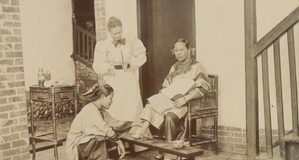The Sanctity and Disgust of the Female Body in Rosemary's Baby
By
2020, Vol. 12 No. 10 | pg. 1/1 AbstractThis paper explores the woman’s body as a site of sanctity and disgust in the film Rosemary’s Baby. The character of Rosemary Woodhouse is depicted as a pure, virtuous, and feminine figure. She is positioned against other corrupted, sinful women, which reinforces a binary of womanhood. When Rosemary is sexually violated, her sanctity is vandalized. Her subsequent pregnancy introduces a new dimension to the binary: that between sacred motherhood and “disgusting” pregnancy experiences. Rosemary struggles to reconcile her ideals of purity with the horrific transformation her body undergoes. This paper identifies the binary as patriarchal mythology; only when Rosemary accepts motherhood as an amalgamation of sanctity and disgust does she reclaim her autonomy. Nonetheless, not all women are able to replicate Rosemary’s evolution in overcoming doublethink. While she is supported by her privilege, mothers on the margins of society remain oppressed under the binary structure. A woman’s body is a site of both sanctity and disgust. She is expected to embody the aesthetic of clean and polished domesticity, which in turn, domesticizes her. Yet, her body is also the breeding ground of sexual desires and moral misgivings that can contaminate her. This doublethink of womanhood is further exasperated when a woman undergoes pregnancy. In Rosemary’s Baby, Rosemary Woodhouse dresses and acts in a way that establishes her as the complacent and naive ideal of 1960s housewifery. However, her pregnancy changes her body to one of perceived horror and defect. Much of the exposition of the film reveals Rosemary’s underlying anxieties about losing her purity. Her fear is informed by the patriarchal structures that deny any reconciliation between the sacredness and corruption of pregnancy, as well as between “pure” and “impure” femininity. This essay looks at the tension separating these two imagined selves within womanhood and motherhood in Rosemary’s Baby, and possible unification. It also considers this tension in the context of Rosemary’s race and class in comparison to mothers in different socioeconomic situations also struggling for bodily understanding and autonomy. Rosemary’s purity is reflected by her body as positioned within the domestic space. In the opening, we see her as visibly smaller and thinner than her husband, a visual indication of her submission. She dresses in feminine and modest clothing that gives off the impression of chastity. Even when she instigates sex, it is proper, being only with her husband, and tied to the celebration of an upgraded domestic lifestyle. We see her decorate her house in the plain, pastel style that she decorates herself; Rosemary bounds her own body to the domestic aesthetic (Polanski, Castle, Farrow, Cassavetes, Gordon, Blackmer, & Evans, 2006, 0:12:23). In comparison, Terry Gionoffrio, a young woman whom Rosemary meets, is cast as her polluted counterpart. Terry has the darker features of an Italian-American, which are meant to juxtapose Rosemary’s “pure,” white complexion. She is a recovering drug addict, having “contaminated” her body with substances. She also admits that she thought the Castevets took her in to do “some kind of sex thing,” demonstrating a sense of indifference towards maintaining her body’s “integrity” (0:14:46).Despite being groomed by the Castevets as a vessel for Adrian, Terry is killed off when Satan chooses Rosemary. In doing so, the pure woman is elevated above the impure woman. As theorized by Adrienne Rich (1976) in her book Of Woman Born, “masculine imagination has had to divide women to see [them], and force [them] to see [themselves], as polarized into good or evil, fertile or barren, pure or impure” (pg. 34). Correspondingly, purity is aligned with fertility in Rosemary’s Baby, Rosemary being “worthy” of bearing the child and Terry having died without children. By making Rosemary and Terry seemingly adhere to those binaries, the film comfortably and cleanly removes Terry without compromising Rosemary’s virtue. Nonetheless, as Rich (1976) emphasizes, these duality has “nothing to do with women’s actual sensuality and everything to do with the male’s subjective experience of the woman” (pg. 34). It is only when the pure and impure amalgamate within one woman that these patriarchal notions start to collapse—something men will perceive as a threat. One way in which the amalgamation manifests is in pregnancy. When Rosemary gets pregnant as a result of rape, her body’s sanctity is violated. Leading up to the rape, she dreams that she is aboard a ship steered by John F. Kennedy who transforms into Roman Castevet, the leader of the cult. She witnesses Michelangelo’s Birth of Man paintings atop the Sistine Chapel as Guy takes off her clothing, leaving her bare. Guy starts having sex with her, and in the process, he becomes more and more demonic (Polanski, Castle, Farrow, Cassavetes, Gordon, Blackmer, & Evans, 2006, 0:47:13). Throughout the hallucinatory dream sequence, Rosemary’s purity is at war with her experienced perversion. Symbols of religious morality—Kennedy, the first Catholic president of the United States, the Sistine Chapel, and martial consummation—are taken and contorted into sinful behavior. Rosemary’s body is the centerpiece to all of this transgression, and her subconscious reveals a colossal fear of losing purity from the moment of conception. Her fear is founded in the contradiction between cultural portrayals of motherhood and lived experiences of pregnancy. In Catholicism, which is a big influence in Rosemary’s life, the Virgin Mary assigns sacredness to the mother figure. Yet, for her, the reality of motherhood involves a bodily invasion (rape) leading to an alien-like expansion of the body that challenges her feminine smallness. The reason pregnancy is so jarring for Rosemary is because its contradictory purity—a “patriarchal mythology”—is “deeply internalized within women” (Rich, 1976, pg. 34). This is shown when Rosemary discovers she is pregnant and still tries to adhere to her lifestyle of aesthetic: we see her party-prepping (Polanski, Castle, Farrow, Cassavetes, Gordon, Blackmer, & Evans, 2006, 1:16:15). Her visual upkeep is encouraged and prioritized by Guy, who disapproves of her new boyish haircut, which he calls “the worst mistake [she] ever made” (1:01:03). Nevertheless, it soon becomes obvious that this framework of cleanliness can no longer accommodate her, a carrier of sully. As her stomach grows and she becomes frailer, Hutch remarks that she looks “terrible” and suspects something is wrong with her (1:01:47). It is the men in Rosemary’s life who first equate the sanctity of motherhood with aesthetic presentation, who are thrown off by the entwinement of “horror” and “mother.” In the kitchen, Rosemary spontaneously bites into a raw chicken heart. Her body has altered to crave what she would have previously found uncouth and revolting. She sees her own reflection in the toaster and, in shock, runs to the sink to wash her mouth (1:14:24). This scene demonstrates the dissonance pregnant women experience between romanticized visions of pregnancy and their somewhat “horrific” transformations—their bodies are (literally) growing away from their previous constructions of self. Roksana Badruddoja (2016) expresses a similar sentiment in her essay, “The Fantasy of Normative Motherhood: An Autoethnographic Account of Contesting Maternal Ideology.” She writes, “I felt no positive emotions when I saw [my daughter’s] legs trying to push through the taut skin on my oval-shaped, scarred belly, trying to kick. Rather, it scared me á la Sigourney Weaver’s Alien” (pg. 318). The baby is framed as a literal parasite that jabs and harms the mother’s body, contradicting notions of pregnancy being a woman’s biological destiny. Like Rosemary, Badruddoja (2016) experiences pregnancy as a suspension between the “natural and pathological”—the sanctity and disgust (pg. 319). Like Rosemary, her state of suspension and amalgamation are understood as “reproductive threat[s]” by men, feeding into her own fragmented perception of self (pg. 319). Rosemary is finally able to reclaim her bodily and mental autonomy when she accepts the amorphous nature of motherhood in relation to purity and rejects both the binaries and hierarchies created by men. In her essay “Birth Traumas: Parturition and Horror in Rosemary’s Baby,” Lucy Fischer (1992) identifies the moment of redemption as when Rosemary goes through the secret door behind the cabinets to the backroom. In removing the barrier between the domestic and the occult, she “negotiates the geography” that connects “idealized childbirth and […] its disturbing terrain” (pg. 88). Instead of fearing it, Rosemary takes hold of and even embraces the limbo state between sanctity and disgust. When she enters the room to discover her demonic child, she is horrified. Yet, upon hearing the baby’s cry, and with some prodding from Roman Castevet, Rosemary rocks the cradle to comfort the baby. In her blue nightgown, she is the spitting image of the Virgin Mary, a symbol of her self-sacrifice for her child (2:09:47). Nonetheless, her actions are not so innocent when considering she would be fostering Satan’s second coming. In a way, her intentions are both pure and impure, a complication of the lawful and naïve housewife persona. At the end of the film, Rosemary seemingly subscribes to Castevet’s role for her as the mother to Adrian. However, she also defies Guy in a very non-submissive way by spitting in his face, having fully realized his selfish pursuits. She ultimately crafts Mother and Wife roles that are multi-dimensional and agency-driven. By mothering Adrian, she does not allow herself to “forget” the bodily horrors of her pregnancy as Guy suggests. She is the sacred mother and the monstrous mother, just as she is the virtuous woman and the defiled woman. Rosemary is able to overcome the doublethink of motherhood and comfortably entangle herself with both the pure and the sinful. Nevertheless, perhaps she was only given the chance to do so as an upper-middle-class woman. Mothers within the margins of society are not afforded the same privileges of self-realization, agency, and autonomy. In Rabbit, Run by John Updike (1960), Janice is a poor mother of two. Unlike Rosemary, she does not even have the pretense of aesthetic, her apartment is “horrible,” with “coloring books on the floor, glasses, the bed unmade, dirty dishes everywhere” (pg. 262). The disorderly state of the house, symptomatic of her foregoing her domestic “duties,” implicates her as a “bad mother.” While Rosemary strives for perfection, Janice toes the line of passable (“the kitchen is clean enough” (pg. 263)). Other than being surrounded by grime, Janice also contaminates her body by drinking alcohol. In contrast to Rosemary’s original purity, due to her class, Janice is assigned “impurity” from the outset. Her fatigue, frustration, and escapism are all consequences of her poverty, but she is not given the opportunity to redeem herself by showcasing her complexity, forever to be reduced to a caricature of deplorable motherhood. Janice attempts to regain a little bit of purity within the messiness by bathing her baby. In the act, she is briefly saintly, “drop[ping] gently to her knees by the big calm tub,” as though in spiritual deference (Updike, 1960, pg. 264). Bathing the baby can be interpreted as Janice’s self-sacrifice: she tries to give her child the cleanliness she herself cannot attain. But, the sanctity of the moment is immediately ripped away from her when “the pink baby sinks down [in the tub] like a gray stone” (pg. 264). She unknowingly performs possibly the worst act of motherhood—killing the baby you are meant to protect. Juxtaposing Rosemary, Janice is never able to break free from her original categorization of “bad mother,” spiraling further and further into its constraints. As Rich (1976) notes in Of Woman Born, “even when [a lower-class mother] is trying to cope with an environment beyond her control […] in the eyes of society the mother is the child’s environment” (pg. 53). As a result, Janice’s tarnished body can never support purity in her child’s body as the state of the two are viewed as uniform. While Rosemary is framed as the victim of disgust—it had entered her body without her consent—Janice is implicated as its creator. For mothers with oppressed identities, the binary of sanctity and disgust stands firm under a prejudiced society. Rosemary’s Baby is a microcosm of society’s categorizing of women’s bodies as pure or impure, which is further complicated by motherhood. For Rosemary, pregnancy coalesces the two opposing aspects, posing a threat to patriarchal binaries as well as her understanding of self, which had formed around those binaries. Whereas Rosemary is able to attain autonomy by embracing both sanctity and disgust, the same cannot be said for marginalized mothers, like Janice, whose corporeal texts permanently read as impure. With Rosemary and Janice’s differing backgrounds, it can be observed that the division of women is oppressive no matter what class or color, yet systematically weighted against marginalized people. As Rich points out, “because short-term advantages are often the only ones visible to the powerless, [women], too, have played [their] parts in continuing this subversion” (35). To address the needs of those who do not have Rosemary’s tools of self-discovery and -fulfillment, a complete overhaul of the schismatic system is necessary. When the most sidelined women are given bodily autonomy and agency in mothering, all women will symbolically walk through the secret door behind the closet to uncover the backrooms of patriarchy. ReferencesBadruddoja, R. (2016). The fantasy of normative motherhood: An autoethnographic account of contesting maternal ideology. In Badruddoja R. & Motapanyane M. (Eds.),“New maternalisms": Tales of motherwork (dislodging the unthinkable)(pp. 315-323). Bradford, ON: Demeter Press. doi:10.2307/j.ctt1rrd820.22 Fischer, L. (1992). Birth traumas: Parturition and horror in "Rosemary's Baby".Cinema Journal,31(3), 3-18. doi:10.2307/1225505 Polanski, R., Castle, W., Farrow, M., Cassavetes, J., Gordon, R., Blackmer, S., Evans, M., ... Paramount Pictures Corporation. (2006).Rosemary's baby. Hollywood, Calif: Paramount Pictures. Rich, A. (1976).Of woman born: Motherhood as experience and institution. New York: Norton. Updike, J. (1960).Rabbit, run.[1st ed.] New York: Knopf. Suggested Reading from Inquiries Journal
Inquiries Journal provides undergraduate and graduate students around the world a platform for the wide dissemination of academic work over a range of core disciplines. Representing the work of students from hundreds of institutions around the globe, Inquiries Journal's large database of academic articles is completely free. Learn more | Blog | Submit Latest in Women's & Gender Studies |


















